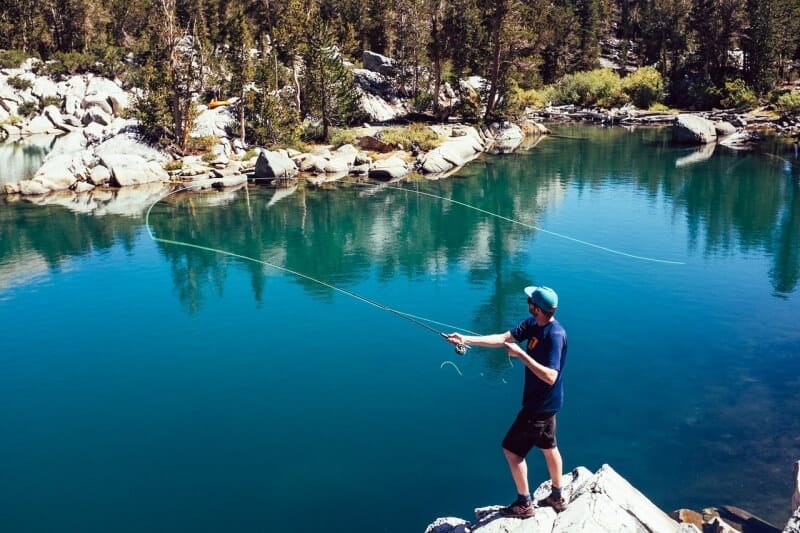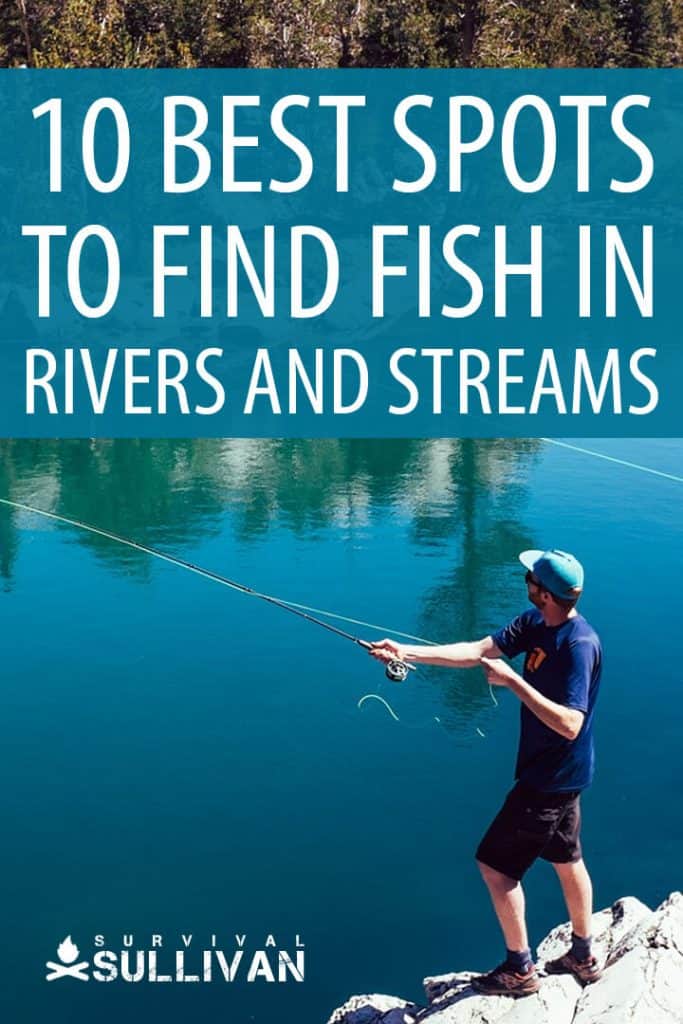Whether you are in waders, fishing from the bank, on a boat or kayak, there are certain secret places to look for the fish to ensure a good catch.
And it is the person who has watercraft skills, as opposed to bushcraft skills, who will always (or nearly always) come home with fish for the family, whereas other less savvy anglers, despite having the high end rods, reels and tackle, will be disappointed.

Table of Contents
Learn Where to Find Fish Before SHTF
It is always a good idea to go fishing in the rivers and steams around your area, and possible bug out locations you have earmarked, well before any threats occur. You’ll then be way ahead of the game in a SHTF situation, as you will know where to find the fish and secure a decent catch for your family.
Fish is a good source of protein and the great part is that the fish are hidden in rivers – so it’s not a resource like livestock that can be stolen/lost in survival situations. If you know where to look, you can access your secret ‘fish stash’. Also be careful about checking for pollution in rivers before fishing.
Why Fish Is Useful for Survival
Many fish that are high in calories also provide healthy fat and omega 3’s for heart health and longevity. The omega 3’s in oily fish help with ageing, vision and mental health according to various studies.
Two servings of fish a week is recommended by the American Heart Association, and countries like Japan where the population eats a lot of fish are notably healthier and long-lived than populations that subsist on meat. In fact, a study that took 16 years and covered the diets of half a million people found that longevity was improved with a diet high in fish.
The fish calories per serving can vary substantially between different species, but no matter what fish you manage to catch and add to your diet it is going to be an improvement on no fish at all.
The 80/20 Rule
Fisherman talk about the 80/20 rule, meaning 80% of the fish will be found in only 20% of the river area, which can leave new anglers with a large area to cover in order to find the fish (especially if the river or stream is new to them).
In order to maximize the chances of catching in order to feed a family in SHTF situations there are a few tried and trusted places to find the fish in any river.
Fish have their preferences for what makes them comfortable and these include:
- Safe rest areas
- Water temperatures to suit their species
- Availability and type of food
- Current strength
- Depth of the water
- Salinity – if applicable
- Dissolved oxygen
If you want to catch trout, for example, then you can look for a combination of the above factors to obtain a better chance of success in taking some home for the pan.
The 10 spots to look for fish given below may have a combination of the above factors such as water temperature and current, or focus on just one aspect such as depth, but overall these are the places fishermen tend to find their catch in rivers and streams.
1) Quiet Spots Along the River
The most obvious places to move away from are areas of activity as the fish shun these in favor of the quieter spots where they will not be disturbed by lots of people near or swimming in the water, dogs barking and dashing into the water, or the noise and disturbance when people launch boats and start up the motors.
All the activity stirs up mud on the bottom making visibility poor and most fish species like to see what is happening around them in order to react to danger or a possible food source.
2) Eddies
Fish prefer to be able to relax in the quieter backwaters, then dart out and find their prey as it comes along instead of using their energy in constantly battling the currents. The ideal spot to find fish is a quiet area near to a faster moving current where the fish rely on the current bringing along all sorts of goodies for their meals.
Look for eddies where the current turns and flows upstream a little. This usually happens where rocks or gravel have formed a barrier, or a tree has partially fallen across the river creating a blockage to the flow of water.
The water will find a way past the obstruction, but will also create a calm area where it flows back on itself, and it is in these eddies that the fish hang out.
3) Converging Currents
Where two currents converge, let’s say past an island in the river or a big boulder, the place where the two converge will usually form a distinct line in the water and it is between these that you will often find fish as the temperature of the water may be different – one current going past the sunny side of the island and one on the shadow side.
Smaller bait fish and insects will have preferences for either the warmer or cooler side and the larger fish can take their pick of prey. These fish lanes or narrow currents often bring along food with them making them doubly attractive.
4) Structures to Provide a Safe Haven
Fish find safe haven among the roots of trees growing into the water. Birds tend to roost and build their nests on the boughs overhanging the water, where they will be safe from predators.
For fish this provides an ideal place to hang around – the tree roots offer safe haven, the bird excrement attracts various types of aquatic creatures which the fish may make a meal of, and if eggs or nestlings fall into the water the fish are right there to snap up the meal from above.
Trees are not the only structures – a manmade crib or a dock or pontoon may provide them with safety. You can also expect to find fish where the bank is undercut.
The fish can’t be seen from above by predators and make themselves comfortable in the rocky ledges underwater, from where they can dart out to seize prey before returning to the relative safety of their ledge.
The type of rock formation above the water will tend to be the same as that underwater – so if you see ledges with hollowed out areas and bands of sedimentary rock above then it will be bound to be the same underwater with lots of hidey holes.
5) Where Tributaries Join the Main River
Where smaller streams join the main river there are differences in temperature and flow bringing more food for the fish and they like to lie in wait at the confluence where the smaller creek is slowed by the broader waters of the main river.
Once you have learnt where to look you can take advantage of smart technology to help see exactly where the fish are lurking.
The Deeper START castable fish finder generates its own Wi-Fi signal, anytime, anywhere, so no mobile data or connectivity is required.
This little device that is light and easy to cast out with your rod will, in conjunction with the Deeper App, display the fish location, the depth they are hanging out, their size and show the vegetation and the contour of the river bed.
The app is free, compatible with Android and iOS devices, updated monthly and has millions of users.
6) Depth Changes
Quieter pools at the beginning and end of rapids or where the water has gouged out deeper areas around large boulders create differences in temperature. Deeper water also provides fish some protection from eagles, herons, and kingfishers, and is warmer in winter and cooler in summer.
Disclosure: This post has links to 3rd party websites, so I may get a commission if you buy through those links. Survival Sullivan is a participant in the Amazon Services LLC Associates Program. As an Amazon Associate, I earn from qualifying purchases. See my full disclosure for more.
If you want to find cold water fish like trout then the Fish Hawk Portable TD Digital At-Depth Water Temp Gauge will help you find the cooler water so you can set your lines out at the correct depth.
And if you are on a kayak this LUCKY portable hand held fish finder will do the trick. It’s just a pity it’s not waterproof – so get a waterproof bag to keep it safe.
7) Salinity and Oxygen
The levels of salinity and oxygen will affect various fish species, so if you want to catch a particular species then you’ll need to be aware of their requirements; for example trout don’t tolerate higher salinity, but other fish like the striped bass can tolerate salt or water fresh.
Dissolved oxygen, meaning an oxygen atom not attached to two hydrogen atoms is introduced to water either through plant photosynthesis or through rapids, rainfall or breaking waves. Trout need more oxygen than a species like carp, so look out for pools after spots where water has come tumbling over rocks and falls, as this will aerate the water.
While fresh healthy vegetation, can provide more oxygen, if there is decomposing vegetation in the water this will rob the water of oxygen, and the warmer the water the less oxygen it will hold. The amount of oxygen in the water will also affect the feeding habits of fish.
If the water is too cold the fish’s metabolism slows down and it does not require much food so will be reluctant to feed, whereas if the water is too warm the fish also won’t feed as they are too busy trying to get enough oxygen to worry about feeding.
8) River Bends
Slower water on the outside of a river bend is more attractive to the fish than the rushing water on the inside of the river bend as it provides a place to relax in the calmer waters while waiting for prey to be washed down in the faster waters, so they can seize their prey and then retreat into the calmer water to relax again.
9) Wind and Water Temperatures
Like humans, fish don’t enjoy being exposed to wind that creates waves and strong currents or interferes with their ability to spot predators from above, so they will tuck themselves into areas that offer something of a windscreen.
However, their food will tend to be pushed towards the shore on the windward side of a high bluff or bank while their food sources on the leeward side of larger land formation will be pushed outwards.
Various fish species live within a water temperature range specific to them, while others can tolerate a wider range of temperature.
If the water is too cold the fish’s metabolism slows down and it does not require much food so will be reluctant to feed, whereas if the water is too warm the fish also won’t feed as they are too busy trying to get enough oxygen to worry about feeding.
Trout and salmon like the deeper pools and a temperature of between 40 to 50 degrees Fahrenheit. Bullhead catfish on the other hand do well in temperatures within the 85-degree range. If you are looking for a specific type of fish then buying a thermometer to take the water temperature is a useful accessory to have.
The best place to find one is at a fishing store, as some of those sold online have proved disappointing. By eliciting the advice of a salesman you will be able to establish whether the temperature indication is accurate, before purchasing.
10) Look for Slow Flowing Water
We mentioned earlier that fish hang around at the confluence of smaller streams flowing into wider rivers, but within the main river the water flow will change in speed according to the gradient – where it is steeper the water naturally flows faster before fanning out into the broad sections of the river where the current slows – and it is here in the slow-flowing water that the fish will lurk.
The ideal spot for fishing doesn’t usually come with a flat piece of grass where you can place your camp chairs for convenient fishing from the side, but if it does, you’re in luck.
What is most important is to combine your newfound skills in watercraft with you bushcraft skills. Think of fish like deer or rabbits – easy to spook – so you need to stalk them, and that involves keeping a low profile on the river bank.
Avoiding loud sounds like items of tackle clanking together and making a noise; keeping your shadow off the water; and being stealthy when you approach areas where you think the fish may be in hiding.
Care to share more fishing tips? leave us a comment below. And don’t forget to pin this for later on your favorite Pinterest board!


Traveler, photographer, writer. I’m eternally curious, in love with the natural world. How people can survive in harmony with nature has fueled my food safety and survival gardening practices.
At the age of 12, I found a newspaper advertisement for a 155-acre farm at a really good price and showed my parents one Sunday morning. They bought it and I happily started planting vegetables, peanuts, maize and keeping bees with the help of the local labor.
Once I married wherever we moved it was all about planting food, keeping chickens and ducks, permaculture and creating micro-climates. I learned how to build wooden cabins and outdoor furniture from pallets, and baked and cooked home-grown produce, developing recipes as I went along.

Great article, except for the river bend information. Depending on the sinuosity of a river, how much it meanders and the rate, the fastest flow is on the outside of a bend for most rivers that are pretty twisty. Only if the bends are gentle and there are not very many does the outside flow slower than the inside of a bend. Simply pay close attention to each and you will be able to see with is the fastest and which the slowest. And as was stated, fish the slower moving water.
Just my opinion.